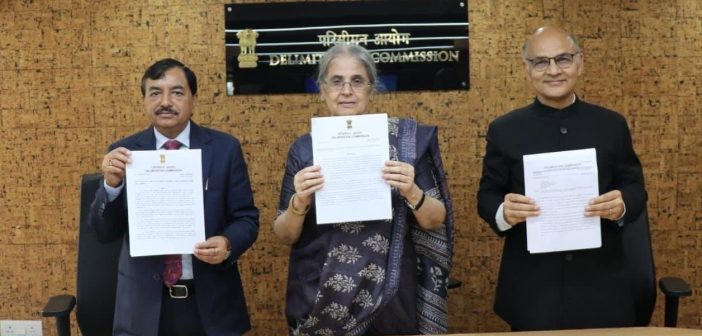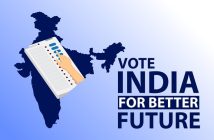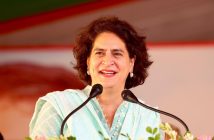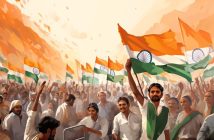After much deliberation, controversies, and objections, the delimitation commission to redraw the electoral map of Jammu and Kashmir has submitted its final report today.
Jammu & Kashmir Delimitation Commission signs the final order for Delimitation of the Union Territory pic.twitter.com/zanO90eBKW
— ANI (@ANI) May 5, 2022
The purpose of the Delimitation Commission for Jammu and Kashmir, which had been appointed in 2020, was to redraw 90 Assembly seats in Jammu and Kashmir.
The completion of the delimitation process would pave the wave for holding Assembly elections in Jammu and Kashmir, which has been without an elected government since June 2018.
As the country awaits the final report, here’s everything you need to know — from what does delimitation mean to what the commission has proposed and why it had triggered protests.
Delimitation explained
Delimitation is the act of redrawing boundaries of a constituency, be that of an Assembly or Lok Sabha seat, to represent changes in in population over time.
It’s only after this exercise has been completed that an election can be conducted.
The purpose of such an exercise is to ensure equal representation to equal segments of the population and ensure a fair division of geographical areas so that all political parties or candidates contesting elections have a level playing field in terms of the number of voters.
The exercise is meant to be carried out every few years after the Census to ensure that each seat has approximately an equal number of voters.
As of date, India has had four such exercises carried out — 1952, 1963, 1973, 2002, although the last of those did not result in any change in the number of Lok Sabha seats, which were frozen in 1976 till 2026 by way of amendments to constitutional provisions, reports News18.
Delimitation in Jammu and Kashmir
Until it lost its special status through the abrogation of Article 370, the delimitation of Jammu and Kashmir’s Lok Sabha seats was governed by the Constitution of India and that of Assembly seats, by the Jammu and Kashmir Constitution and Jammu and Kashmir Representation of the People Act, 1957.
The last such exercise in the now Union Territory was in 1995 and based on the 1981 census. The J&K Assembly in 2001 had passed a law putting on hold delimitation until 2026.
However, after Jammu and Kashmir lost its special status and became a Union Territory, a Delimitation Commission was set up to redraw boundaries of Parliamentary and Assembly constituencies.
The Commission was formed on 6 March 2020. It is headed by Justice Ranjana Prakash Desai (retired), Chief Election Commissioner (CEC) Sushil Chandra Sharma and State Election Commissioner (SEC) KK Sharma. In the absence of the Legislative Assembly, National Conference and BJP Lok Sabha members were nominated as associate members of the Delimitation Commission but did not have any voting rights.
What the Commission proposed and the opposition to it
The Delimitation Commssion in its proposal has suggested that the number of Lok Sabha constituencies remain at five.
However, the Assembly seats be increased from the present 83 to 90 (adding six in Jammu and one in Kashmir).
This will take the total seats in Jammu to 43 from 37 and in Kashmir from 46 to 47. Ladakh will continue to have four seats.
According to reports, the commission also proposed the reservation of seven seats for Scheduled Castes and nine for Scheduled Tribes. It also proposed the reservation of 24 seats for Pakistan-occupied Kashmir (PoK).
The suggestion to increase seats in Jammu set off a political fight, with local parties describing it as an attempt to tilt the balance of power towards Jammu.
Omar Abdullah of the National Conference had then tweeted:
The draft recommendation of the J&K delimitation commission is unacceptable. The distribution of newly created assembly constituencies with 6 going to Jammu & only 1 to Kashmir is not justified by the data of the 2011 census.
— Omar Abdullah (@OmarAbdullah) December 20, 2021
Former Chief Minister Mehbooba Mufti also slammed the Delimitation Commission, saying, “This commission has been created simply to serve BJPs political interests by dividing people along religious & regional lines.”
My apprehensions about the Delimitation Commission werent misplaced. They want to pitch people against each other by ignoring the population census & preposing 6 seats for one region & only one for Kashmir. https://t.co/Dbs1Mny3iE
— Mehbooba Mufti (@MehboobaMufti) December 20, 2021
Their argument was that the delimitation exercise was meant so that all populations be equally represented. The Census of 2011 shows that Kashmir had 15 lakh more population than Jammu – 68.8 lakh vs 53.5 lakh.
So, then how could Jammu get more Assembly seats than Kashmir?
There were other flaws too in the delimitation process, alleged the local parties, adding that these could have far-reaching effects on the democracy of the region.
For instance, the Commission suggested the merger of Rajouri-Poonch areas with Kashmir’s Anantnag parliamentary constituency. Besides the population issue, which could tilt the poll outcome in favour of the BJP, there was also the geographical issue to consider.
National Conference spokesperson Imar Nabi had told Indian Express that his party failed to understand the logic behind this merger given the “huge geographical distance” between Anantnag and the Pir Panjal region in Jammu. In fact, Shopian – the last inhabited town of south Kashmir on the Mughal roads that connects Kashmir with Pir Panjal – is over 100 kilometres away from Thanamandi, the last inhabited town of Poonch-Rajouri region.
What next?
Only after the Delimitation Commission’s final report is accepted, will polls be conducted in the Union Territory.
As per a report by Times Now, the Assembly elections are expected to be held in October 2022.
Union Home Minister Amit Shah had recently assured that elections would be conducted after the delimitation exercise was over and in consultation with political parties.




